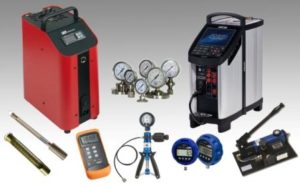Measuring Instruments
Some common measuring instruments generally used in bench work or fitting shop are micrometer, vernier caliper, depth gauge, and vernier height gauge. These are discussed as under.
Micrometers
The micrometers are commonly employed for measuring small dimensions with extreme accuracy of 0.01 mm. They may be of the three kinds –
(a) External micrometer for measuring external dimensions,
(b) Internal micrometer for measuring internal dimensions, and
(c) Depth micrometer for measuring depths.
For measuring a dimension in external micrometer, the work piece is held between the fixed anvil face and the spindle face of the micrometer. The spindle of the micrometer is allowed to move linearly towards the work by rotating thimble. When the spindle will touch the work piece properly, the ratchet will give its sound. The small locking lever is then rotated to clamp the spindle so that reading can be taken more accurately. Outside micrometers are used for measuring the outside dimensions of jobs, such as diameter of a bar, rod and thickness of plate. Generally, until and unless they are provided with the vernier attachment, the former can read up to 1/1000 or 0.001 inch and the latter up to 0.01 mm. The former are known as inches micrometers and the latter metric micrometers, which are gradually replacing the former due to the introduction or adopting of metric system. Inside micrometers are commonly used for measuring inside dimensions of the objects, such as inside dia. of a hole, width of a slot or cavity, etc. The outside micrometers are the most extensively used in industrial applications. All the micrometers, irrespective of the fact as to whether they carry graduations in inches or millimeters, are similar in construction. An out side micrometer is discussed as under.
OUTSIDE MICROMETER
Fig. shows an outside micrometer. It consists of the following main parts.
1. Metallic frame
2. Axial graduated sleeve
3. Circumferential screwed spindle
4. Hardened steel anvil
5. Thimble
6. Ratchet stop screw
7. Lock nut
Micrometer works commonly on the principle of nut and bolt assembly. The sleeve carries inside threads at the end, which forms the nut, and the screwed part of the spindle passes through it. The spindle and the thimble are secured to each other such that by rotating the thimble the spindle rotates. With the result, when the thimble is revolved, it advances towards or retards away from the fixed anvil, together with the spindle of the micrometer. The sleeve carries the graduations, which, in conjunction with the beveled and graduated part of the thimble, give the measure of the opening between the end faces of the anvil and the spindle. The ratchet arrangement provided at the end of the thimble prevents the spindle from pressing further against the surface of the piece being measured after the required feel has been attained, thus facilitating a uniform reading and preventing the instrument from being damaged. Lock nut or locking lever is used for locking the micrometer for a desired amount of time after taking or setting the reading. The construction of the outside micrometer is discussed as under. Source A Textbook of Basic Manufacturing Processes and Workshop Technology by Rajender Singh.
